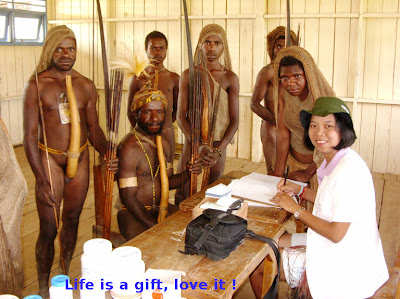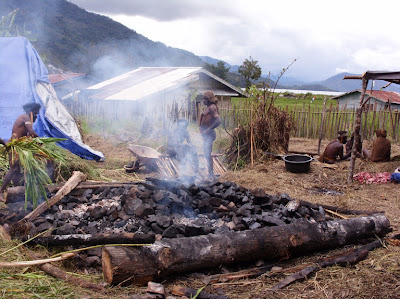Muspas
is Musyawarah Pastoral (Pastoral
Deliberation) for Mee tribe and Moni tribe. The third Muspas was held in Obano village
from Febuary 26 until March 4, 2011.
There
were about 3000 people of Mee tribe and Moni tribe came from Paniai Regency,
Nabire Regency, Mimika Regency, Deyai Regency and Dogiyai Regency to have an
annual Pastoral Delibration (Muspas) in Obano village.
Every
group represented their parish and they brought sweet potatoes, taros, sugar canes,
carrots, cabbages, tomatoes, pigs, fishes, lake lobsters, buffalo, etc. Papuan
men and women are very strong. They could carry heavy things on their shoulders or their heads. They cooked all of this raw material and ate
them together. The women were so busy cooking in the big outdoor kitchen. Can
you imagine how to cook for 3000 people???
You can see in the picture, the ladies were preparing many big pots of lake
lobsters (Cherax albertisii) for our meals.
They
danced together happily. Please look at the picture, the children were dancing
by shaking their hips to the right and to the left while jumping lightly, so you can see their moge (wooden
tassel skirts) were waving. This dance is called Waita
Dance but I used to call it “the shaking ass dance”. LOL. Hey…
there were so many little Beyonce in here. Hahahaha…
This
is a Catholic event for gathering Mee tribe and Moni tribe, but since some of
Mee and Moni tribe people are Protestant, so this event is held for gathering
all the people from Mee and Moni tribe who are scattered in different regency in Papua. This
event opened with a holy mass at Saint Fransiskus Church in Obano village. The Mass was led by Bishop of the Diocese of Timika, Mgr. John Philip Gaiyabi Saklil, Pr.
This event was also attended by Klemen Tinal (the Regent of Mimika Regency), many Catholic
priests, Catholic sisters and Protestant priests.
There
were about 16 tents for 3000 people from men, women to children. All tents
were so crowded. My duty was taking care the sick people. I had more than 100
patients per day. Some patients came to me with many injuries. I was so busy at
that moment. Look at the picture, I was taking care the wound of Pace Leo (Pace = Mister).
The
aim of this event was to build a strong
faith in God,
respect Emawaa (chapel),
Owadaa (community gardens) and preserve the culture for young Papuan being displaced
by modern culture. That
was why in this event, they used their traditional costumes like koteka
(the penis sheath), moge (the wooden tassel skirt), noken
(wooden bag) and many accessories. Koteka
is made from vegetable marrow (Lagenaria siceraria) although other
species, such as Nepenthes mirabilis, are also used. They
are held in place by a small loop of fiber attached to the base of the koteka and placed around the scrotum. There
is a secondary loop placed around the abdomen and attached to the main body of
the koteka (look at the picture).
Men
choose kotekas similar to ones worn
by other men in their cultural group. Sometimes they put something inside the koteka like money and tobacco. Some wear
them pointed straight out, straight up, at an angle, or in other directions. Maybe
you wonder why there are many sizes of koteka.
The diameter of the koteka can also
be a clue. Contrary to popular belief, there is little correlation between the
size or length of the koteka and the
social status of the wearer. Kotekas
of different sizes serve different purposes: very short kotekas are worn when working and longer and more elaborate kotekas are worn on festive occasions.
The
Papuan women wear moge to cover their
vagina and usually they are bare breasts. Things are so different now, since
the modernization, the young women prefer to cover their breasts with wooden
tank top while the old women are okay without wooden tank top. On this
occasion, I had an opportunity to use Papuan woman traditional costume. I worn moge and wooden tank top because I didn’t want to bare breasts. Hahaha…
In the
picture, I was posing with Papuan women. I was using colorful moge, wooden tank top, wooden veil and a
statement necklace. Of course my costume was so different because I was the
Papuan Princess. LOL.
If
you come to Papua, please don’t expect to see the native people are wearing kotekas and moges everyday because they are wearing modern clothes now. Only
few old people who still wear their traditional costumes daily and you can only
meet them in a very remote village. Nowadays, many young people in the village
used mobile phone, digital camera, digital video, laptop, and many electronic
gadgets. You can see it from the
picture, a man was using his mobile phone to take a picture and he had a pack
of cigarette on his waistband.
The peak of the event was the blessing of the new chapel by Bishop of the Diocese of Timika, Mgr. John
Philip Gaiyabi Saklil,
Pr. The Papuan slaughtered piglets instead
of lamb and put its blood on every door of the chapel. You can see it from the picture, the Papuan man was slaughtering the piglets .
As a sense
of unity and
brotherhood,
The Papuan having “Barapen” (pesta
bakar batu). They cooked the pork over the hot stones and leaves. They used Barapen as an
opportunity for residents to
gather. In this
party will be seen how high the
solidarity of Papuan is.
Another meaning of
this feast is an
expression of mutual forgiveness between
people.
Barapen
procession usually consists of three stages: preparation, roasted pork,
and eat together. The preparation stage
begins with the search of firewood and stones to
be used for cooking. Stone
and wood arranged in the following order, at the bottom laid large stones,
on top covered with wood, and then laid
another smaller stones,
and so on until the top is covered with
wood. Then the pile is burned up and
burned wood to
heat rocks. All this things usually done by men.
The other men prepared a large
hole based on
the large number of foods that will be cooked. They covered the bottom of the
hole with reeds and banana leaves. By using a special timber (looks
like a big chopstick), hot stones were
arranged on leave, and then covered with
reeds. Then they put the pork at the top of the reeds and covered again with foliage. On top of these
leaves, they closed again with
burning stones, and covered with thick grasses.
After that, they arranged sweet potatoes on it. The next layer is
deposited weeds again
with a smoldering rock. They put leaf vegetables
such as sweet potato leaves, cassava
leaves, papaya leaves, chayote leaves on
it. The next hole was back filled again with burning
grass and stones. On
the top, they placed banana
leaves sprinkled with soil
as a barrier to
keep the heat from the stones so
that the heat do not evaporate. It takes about 60 to 90 minutes for cooking all these things. When
it is ripe, the grass will be
opened and they take the food (pork, fruits and
vegetables), and then spread all
those things on the grass. After
the food is laid on top, there are people
who will take the ripe red fruit (Pandanus conoideus) and squeeze
the red fruit over the food. Salt and flavorings
are also sprinkled on the food. It taste really goooooood.
I
was so lucky to experience this event in my village Obano, because not everybody
has the chance so see this event. When and where else I can see people wearing koteka, moge, noken, and eating
barapen?????
Im so proud to wear Papuan woman traditional costume and be part of
the party.















Another great insight ito the lives of the Papuan people. Look forward to your next post Sinthya.
ReplyDeleteIan
Thank you Ian :)
DeleteFirst-hand accounts like this are hard to find on the Internet or anywhere. The people who inspired you to create this blog will be pleased and proud.
ReplyDeleteThank you Walt :)
DeleteA real jungle princess wouldn't wear the wooden tank top!
ReplyDeleteThanks for your comment :)
Delete